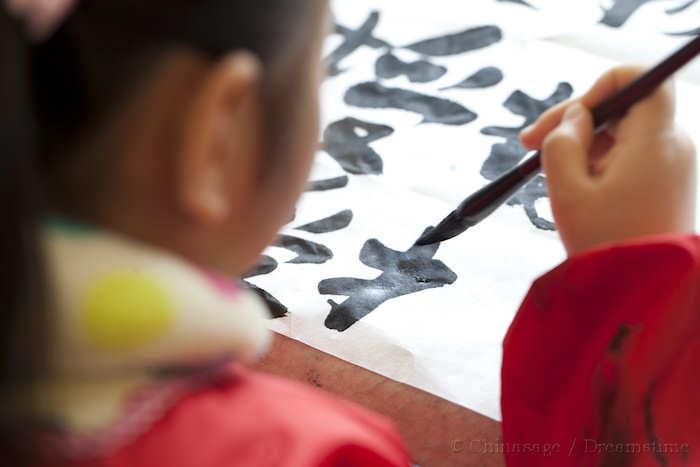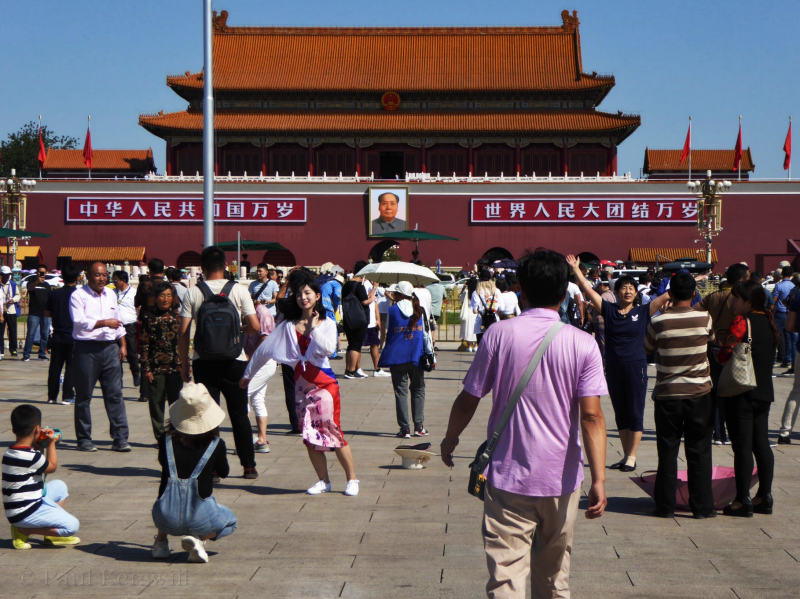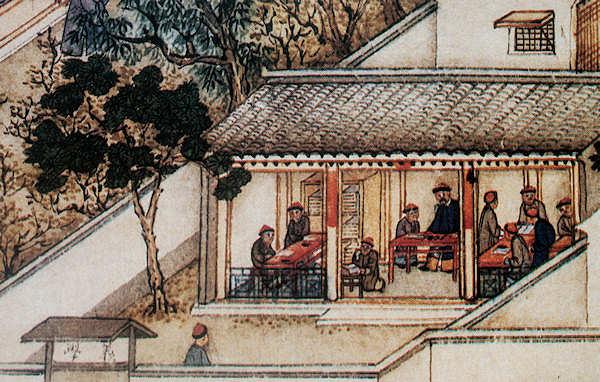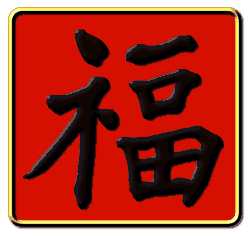Speaking and Reading the Chinese Language

Understanding a little of the great treasure of China, the Chinese language, opens up a deeper appreciation of the country. In continuous use for thousands of years, the language is a vast treasury of culture; in this regard it is only really rivaled by the ancient Greek language ➚. Within this section we look at the characters, some basic words, how they are written, how they are typed in and also poetry and literature. There is an extensive collection of Chinese proverbs. Our look at oracle bones shows their ancient heritage. We have our own translations for the ancient language primers : one hundred names, thousand character classic and three character classic. We do not provide a full language course but a gentle introduction to the language in three introductory lessons.
There is also a full reference to the most common Chinese characters - with dictionaries organized by radical, by pinyin pronunciation and by component parts. Our extensive online dictionary helps you translate any Chinese you may come across. We also look at the reason for the many names used to refer to the country of 'China'. We show how numbers are written in Chinese and how to tell the date and time in Chinese. Looking at the cultural backdrop behind the language we take a detailed look at the character for good luck.
Myths about the Chinese language
Here are a number of myths to dispel.
- Chinese is a very difficult language. Although some things look difficult, it is just as easy as any other language to pick up enough Chinese to get by with.
- Each character is a ‘word’. This is not often the case, often two or three characters are needed in Chinese as a translation of a single English word.
- The written language is symbolic and not phonetic. This is not correct in general, most characters include hints on how the characters should be pronounced.
- Chinese does not have a full grammar. Although Chinese does not have declensions or tenses in the same way that many other languages do this is more than compensated for in use of special ‘particles’ and grammatical structures.
- ‘Pinyin’ can be used to speak Chinese fluently. The sounds used for vowels and consonants in spoken Chinese overlap the ‘Latin’ forms used in English a little, some are similar, others are totally different and have to be learned as new sounds. You need to learn these new sounds to be understood in China.


Chinese Characters
There are over 7,000 Chinese characters in regular use, far more if you include archaic ones that are used in ancient texts. These characters are built up into ‘words’ by combination - typically in pairs, there are about 500,000 ‘words’ in Chinese. However 500 characters are adequate to get by with in everyday conversation, and about 2,000 to read a newspaper (this is considered the basic test of literacy). From 2,000 years ago it has been expected that a literate child of 12 years old would know 5,000 characters. The characters are spoken as a single syllable and come in a number of classes, the ancient set that occur most frequently are ancient pictographs (tree, sun, mouth, me, you, field and so on). Many of these are an identifiable pictorial representation of an object. Most, about 90%, of Chinese characters are composite, they have one part ‘the radical, that signifies the class of ‘thing’ or its pronunciation and the other part which gives it a specific meaning. So a ‘heart’ radical immediately alerts you that the whole character has something to do with emotion, or a ‘woman’ radical for characters to do with female gender. There are 214 recognized radicals in Chinese. For more about the history and symbols in characters see pictographs.
The largest class of characters use radicals not to convey meaning but pronunciation. Over time these characters may have lost their ‘sounds like’ link and just have to be learned. Partly due to the number of homophones in Chinese (there are over 50 meanings for ‘shi’ spread between the five tones see Shi Poem ➚), a single character is rarely sufficient to be understood on its own. Either the context will make it clear (for example shi as the number 10 will be in a numerical context) or more usually by in combination with another character. Often two characters combine to reinforce each other, as they both mean more or less the same on their own. An example is ‘peng you’, the character 朋 péng means friend and so does 友 yǒu, and putting the two together 朋友 péng yǒu means ‘friend’ unambiguously.
The disadvantage of a non-phonetic language is that you can not guess how to write a character when you hear it said and conversely just reading a character does not allow you to say it out loud. A language of this type has to be centrally controlled as there has to be agreement as to how to write and pronounce new characters.

Using Chinese Dictionaries
If you see a character you do not know it is hard work to look it up in a dictionary. You first need to analyze its structure and identify the radical part. This is usually to the left or top of the main part, but not always. The dictionary orders radicals and characters by the number of strokes used to write it. One stroke of the brush may make multiple ‘lines’ so a starting point has to be to learn how characters are written (see our writing guide). Once identified you look up the radical part in the dictionary and this in turn takes you to a list of all the characters that use the radical ordered by number of strokes used to make the remaining part. The dictionary then takes you to a page describing the meaning of the character in the body of the dictionary ordered by pinyin. However if you know the pinyin it is easy to look up by order of the pinyin sound. This process is for looking up printed characters in books and magazines, anything on the Internet can now much done much more easily by a computer, for example using our own online dictionary or Wiktionary ➚.

Spoken Chinese
There are many varieties of spoken Chinese which allow the same written form to be spoken in different ways. This key feature allows people from disparate places in China to make themselves understood by writing rather than speaking.
Only about 60% of people in China speak mandarin regularly. The other Chinese languages in widespread use include Wu (Zhejiang) 77 million; Yue (Guangdong/ Guangxi/ Overseas) also known as Cantonese; Min (Fujian/ Guangdong/ Taiwan) 60 million; Jin (Shaanxi/ Shanxi/ Inner Mongolia) 45 million; Xiang (Hunan) 36 million; Hakka (Guangdong/ Overseas) 31 million; Gan (Jiangxi) 30 million; Hui (Zhejiang/Anhui) 3 million; and Ping (Guangxi) 2 million. The large emigration of people from Fujian and Guangdong has given Yue (Cantonese), Min (Hokkien) and Hakka a worldwide distribution. For example, many Chinese restaurants in the UK are run by Cantonese speakers.
There are also a diverse range of regional dialects with their own slang terms and pronunciations. Particularly in rural areas the local dialect may be very hard to understand. Sichuan is one province with a strong regional accent, here a word like Hunan is pronounced more like Fulan.
It should also be stressed that ‘Chinese’ is not the only language used in China; Arabic, Russian and Tibetan are all entirely separate major languages quite apart from those spoken by the minority peoples. There are four main groups of minority languages: Altaic (Mongols, Uighur and Kazakh); Tibetan-Burmese (Tibetan, Yi, Hani, Tujia); Thai (Zhuang, Dai,Dong) and Yao/Miao. In cities the English language has been avidly learned by the younger generation as a passport to a better job. So English tourists can usually find an English speaker to help in cities, although this is not the case in rural areas.
For more on the Chinese language please visit That’s Mandarin ➚.
Historical types of Chinese
When studying old Chinese literature it has to be appreciated that there is more than one written 'language' in use. There are at least four different forms :
- Ancient style as used in the Yi Jing and other Classics dating back two thousand years or more. It is very concise, rather ambiguous and hard to understand. It has no punctuation marks.
- A literary style was used by the educated elite throughout China's dynastic history (文言 wén yán). It is more like poetry than prose. Really only intelligible to those with wide historical knowledge. Can be compared to the use of Latin in pre-medieval Europe.
- Business style for commercial purposes. Used for legal documents and correspondence.
- Colloquial style (the spoken language 白话 bái huà). This is the modern 'universal' style of spoken language. The language pages used here are all in this modern style.

The Mandarin dialect
The official dialect used in China is the one spoken in the Beijing area. It is called the Beijing dialect; Mandarin (官话 guān huà) or Putonghua (普通话 universal common speech). The dialect became established as the language of government and administration in the Yuan dynasty 600 years ago. It gets its name from the name for the government officials who spoke it. Even within standard mandarin there are a number of strong regional dialects. So it is not uncommon for Chinese from different provinces, both speaking mandarin to have difficulty understanding each other. Deng Xiaoping for example had a strong Sichuan accent making him hard to be understood in Beijing.
Mandarin Tones
In English ‘tone’ of voice is used to convey nuances of meaning, in Chinese the meaning changes completely. So in English a long vowel sound for ‘very’ can stress it, or, a rising tone at the end can turn a sentence into a question. In Chinese words for ‘ten’, ‘city’, ‘exist’, ‘lion’, ‘use’ differ only in tone. Only careful listening and long exposure can give a native English speaker any true appreciation of the subtleties of tone. The different spoken languages have different tones, for example the Cantonese dialect uses nine distinct tones.

Pinyin tones
The mandarin or Beijing dialect uses five tones and these should be put above Chinese vowels to indicate tone. Without the tone marks it is very hard to understand pinyin as there are so many Chinese characters that are only distinguished by tone. The tone marks are difficult to add on a computer and this is why the characters are increasingly used in messages and web sites rather than pinyin. Pinyin was often used in China on official signage underneath the characters and this was invaluable for those learning the language - but use of pinyin among Chinese is in decline. The term 拼音 Pīnyīn literally means ‘put together sounds’. Quite often when characters are used together the individual tones are modified, so for example, a third tone is never followed by an unmodified third tone.
| 1 | First: (-) level high tone | 狮 shī | lion | |
| 2 | Second: (/) rising tone | 十 shí | ten | |
| 3 | Third: (v) falling then rising tone | 史 shǐ | history | |
| 4 | Fourth: (\) sharply falling tone | 是 shì | 'is'; exists; correct | |
| Finally there is a fifth, rarer neutral tone with no real emphasis on its own. | ||||
Listen to the mandarin tones
Pinyin Romanization
Mao Zedong could see that the Chinese written characters was an obstacle to reading and writing compared to the western ‘Latin’ alphabet of just 26 letters. This was most evident in the days of typewriters - when thousands of ‘keys’ - one for each character was not feasible. Several attempts over the centuries have been made to write Chinese in a phonetic form for easier understanding. The problem was made evident when the telegraph came to China in the last 19th century, 26 letters could easily be converted to dots and dashes, but not tens of thousands of characters. The approach taken was to assign a number to each character and then transmit this number in ‘standard’ Morse code. The recipient would look up the number and write down the character representation.
Historically there has been a number of ways of expressing Chinese with the Latin alphabet including Yale ➚, Wade-Giles and the modern Pinyin system. The earliest scheme was devised by Matteo Ricci in the 17th century. Later, when Western missionaries went to China in the 19th century, systems were developed based on local dialect but these died out when the Christian missions were ejected. A widely used system was Dr. Robert Morrison's scheme taken from pronunciation around Nanjing. Each country had its favored system as the Chinese sounds were mapped onto the closest equivalent in the native country. French speakers used ‘Ecole Francaise de Extreme-Orient’ (EFEO ➚) while Germans used the ‘Lessing’ system ➚. A fiendish Chinese system developed in 1926 called Gwoyeu Romatzyh ➚ was never widely adopted, even the Chinese found it unintelligible, one of a few relics of this approach is the spelling of Shaanxi with a double ‘a’. Wade Giles is still seen today in spelling of historical figures such as Mao Tse-tung (Mao Zedong 毛泽东); Chiang Kaishek (Jiang Jieshi) Cities: Peking (Beijing); Tientsin (Tianjin); Canton (Guangzhou); Kirin (Jilin) Rivers: Yangtse Kiang (Yangzi Jiang) and cultural history Tao Te Ching (Dao De Jing); I Ching (Yi Jing). We describe the system in detail in our guide to Wade Giles.
The problem with Chinese was most evident when typewriting and printing was the normal form of written communication. English can be easily accommodated with a keyboard, Chinese characters numbering thousands are just impractical to handle in the same way. With computers this drawback has been removed, software will suggest characters based on pinyin and their context making them easy to select (see our description on input methods). The other main drawback of pinyin is that there are many dialects of Chinese that are mutually incomprehensible, pinyin can only reflect the pronunciation of a relatively small proportion of Chinese speakers. So pinyin is only really useful as a teaching aid.
Our guide to Basic Chinese lists out the pinyin system with an indication how each sound is made.
Chinese Grammar
Chinese does not have the regimented structure of some other languages. Because characters are fixed in written form it could not develop the suffixes and variations that allow other languages to express tense, gender, declension and plural. In English many words are made plural just by adding 's', this is not as straightforward in Chinese. Similarly adding '-ed' to a verb in English usually indicates a completed action. With a fixed form the characters can not be modified in the same way, the character for the verb remains the same for past, present or future tenses. The tense for a verb has to be expressed in other ways.
In many cases these apparent limitations are easy to avoid by simply adding an extra character to modify the meaning. One example is 过 guò that puts a sentence into the past tense. Another way is to put a time phrase at the start of the sentence, so Yesterday I go... and Tomorrow I go... clearly express the meaning without changing the verb at all.
For personal pronouns adding 们 mén converts them to a plural form so I 我 wǒ becomes we 我们 wǒ mén. See our Basic Chinese for a gentle introduction to Chinese.
So in many ways Chinese is simpler than English with no need to remember irregular verbs and strange plurals (e.g. child-children; person-people; axis-axes and goose-geese). However there is considerable subtlety in character order and placement which requires careful study. This makes it fairly easy to be understood at a basic level, but to speak and write good Chinese is a lifelong study.

Consonants
To many who are not linguists it is assumed that all spoken languages are based on a similar set of sounds. This is not true and the assumption that words spelled out in the Latin alphabet use the same basic sounds is an easy mistake to make. To speak Chinese well you need to learn to make new sounds and this can prove very tricky if not learned at an early age. Over the last few centuries westerners have sought to write Chinese in a phonetic form using the 26 letter alphabet, it has not proved entirely successful as these do not accommodate sounds only used in Chinese. See our guide to Basic Chinese for all the details.

History of Chinese Language
It is astonishing how stable the Chinese written script has been. Some Shang dynasty (3,500 years ago) characters are clearly similar to their modern form. The main source of these early characters are from archeological remains where they were found inscribed on ‘oracle bones’ for purposes of divining the future (the Romans did something similar).
One of the famous achievements of the First Qin Emperor Qin Shihuangdi was the rationalization of the written script. The kingdoms of the Zhou dynasty had developed similar but different representations of characters in scripts, he enforced the use of the Qin kingdom's script everywhere. By the Han dynasty the first comprehensive dictionaries were written, one written in 121CE had 541 radicals. However the written and spoken languages diverged, so a written script, reserved for scholars (Wenyan ➚), does not reflect the speech as in Baihua ➚. One of the reason for the stability of the language is that the written form was used for Imperial administration and was known only to the scholars and administrators, as this was not the ‘spoken’ language it did not change over time as phonetic languages tend to do. However this approach had the consequence of limiting literacy to only a few people. The system was considered impenetrable and ambiguous because a character could mean many things depending on its context and there was no punctuation. The most recent and radical reform was under Mao's government to help make the language easier to read and write; a large number of characters have been simplified by reducing the number of strokes needed to write them.
In the modern age new characters are needed for a variety of purposes, for example foreign names; new chemical elements; new technical processes and appliances. These are devised by combining existing characters rather than creating brand new ones. Often the characters chosen are similar in sound to the foreign word. For example coffee is 咖啡 Kā fēi and Olympics is 奥林匹克 Àolínpǐkè (transliterates roughly as profound forest equal ability which is not really sport related)
The Chinese have treasured their language for centuries and it is unique in its longevity and elegance.